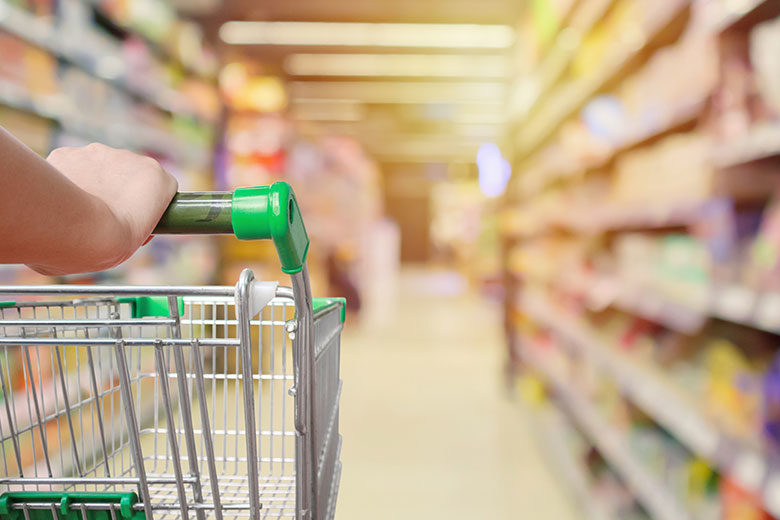
Before any grocery shopping trip, especially one while being quarantined due to COVID-19, planning is necessary. I am not perfect with planning ahead but I’m trying to get better about it to be more efficient and economically savvy while grocery shopping. Here are a few tips to help you feel more organized and calmer in this current state of panic.![]()
Before the Store
- Inventory: Take inventory of what you already have in your pantry, cupboards, refrigerator and freezer. This will help reduce the cost of your grocery bill by not purchasing what you already have on hand.
- Menu Planning: Knowing what you have on hand will help you determine what you need to make meals. If I know I have a bottle of pasta sauce in the pantry but no pasta, I can start making a mental list of what I need. Ask yourself what type of meals will be easy for you to make that your whole family will enjoy. This could be as simple as spaghetti with meat sauce, chili with quinoa or brown rice, mac n cheese with chopped chicken breast, vegetable soup with noodles, or even frozen or canned meals that can be easily heated up when you’re tired of cooking.
- Don’t go to the grocery store hungry! I don’t know how many times I’ve gone to the grocery store and my hunger takes over my plan of getting what I actually need. I end up purchasing unnecessary food items that don’t help with creating meals.
Making a Shopping List
When looking for these products at the grocery store, know that access is going to be limited. It’s okay for you to purchase store brand products or not purchase the most nutritious options. All food is nourishing! Now that you aren’t “hangry” and know what you already have at home, you can look through the following lists and choose which items work best for you and your family.
Canned and Frozen Products
Canned produce is an amazing option that is shelf-stable and is just as nutritious as fresh produce! When looking for canned goods, be sure to choose cans without bulges, rust, or gouges. Avoid cans with dents to help them stay shelf-stable longer. Look out for low sodium canned goods or rinse the canned produce prior to use to reduce the sodium content.
- Canned beans (black, garbanzo, pinto, etc.)
- Canned lentils
- Canned diced tomatoes
- Canned tomato paste
- Canned chili
- Canned fruit in juice
- Canned tuna
- Canned chicken
- Canned salmon
- Canned soups
- Frozen fruit (mixed berries or whatever you enjoy)
- Frozen or canned corn
- Frozen edamame
- Frozen mixed vegetables
- Frozen peas
- Frozen chopped spinach
- Frozen broccoli
- Frozen potatoes, french fries
- Pizza
- Frozen pre-made meals
- Ice cream
Fresh Produce
Here are a few options that last longer.
- Cabbage (red and green)
- Bananas
- Potatoes (sweet and white)
- Apples
- Garlic
- Onions
- Carrots
- Oranges
- Squash
Dairy
- Organic milk tends to last longer than conventional options
- Plant-based milk can be a good alternative that also has a longer shelf-life
- Purchase tubs of yogurt or Greek yogurt instead of individually portioned containers
- Butter
- Cream cheese
- Cottage cheese
- Cheese (shredded, slices, blocks, cubes, string)
- Evaporated milk
Beverages
- 100% Juice
- Carbonated water
- Tea
- Coffee
Grains and Starches
- Cereal
- Oatmeal
- Quinoa
- Rice (white or brown)
- Popcorn
- Pasta
- Instant noodles
- Crackers
- Breadcrumbs
- Flour
- Boxed mac n cheese
- Instant mashed potatoes
- Bread (white or whole grain)
- Waffles
- Bagels
- Muffins
Protein
You can extend your animal-based protein by combining it with plant-based options such as tofu, peas, beans or lentils.
- Eggs
- Firm tofu
- Frozen meat alternatives
- Meat:
- Ground beef
- Frozen burger patties
- Sausage
- Deli meat
- Beef stew meat
- Poultry:
- Ground chicken or turkey
- Chicken breast or thigh
- Frozen precooked or raw chicken
- Deli meat
- Frozen seafood (shrimp or fillets)
Snacks
- Chips
- Cookies
- Trail mix
- Granola bars
- Nuts
- Cake/brownie mix
Condiments and other Basics
- Ketchup
- Mayonnaise
- Oil: olive, canola, vegetable, toasted sesame
- Nut butter (almond, peanut, cashew, etc.)
- Jam or fruit preserve
- Salsa
- Soy sauce
- Taco seasoning mix
- Salt & Pepper
- Vinegar
Be sure to only get what you need. That’s where taking inventory really comes in handy! Grocery stores are doing their best to restock shelves, but we can also do our part to not hoard items including hand sanitizer, toilet paper and shelf-stable foods. This is a time for us all to check in with our neighbors and support people who may not have access to transportation or funds to purchase these grocery items.



